The smart indoor gardening system market is estimated to be valued at USD 2.51 Bn in 2025 and is expected to reach USD 3.88 billion by 2032, growing at a compound annual growth rate (CAGR) of 6.4% from 2025 to 2032.
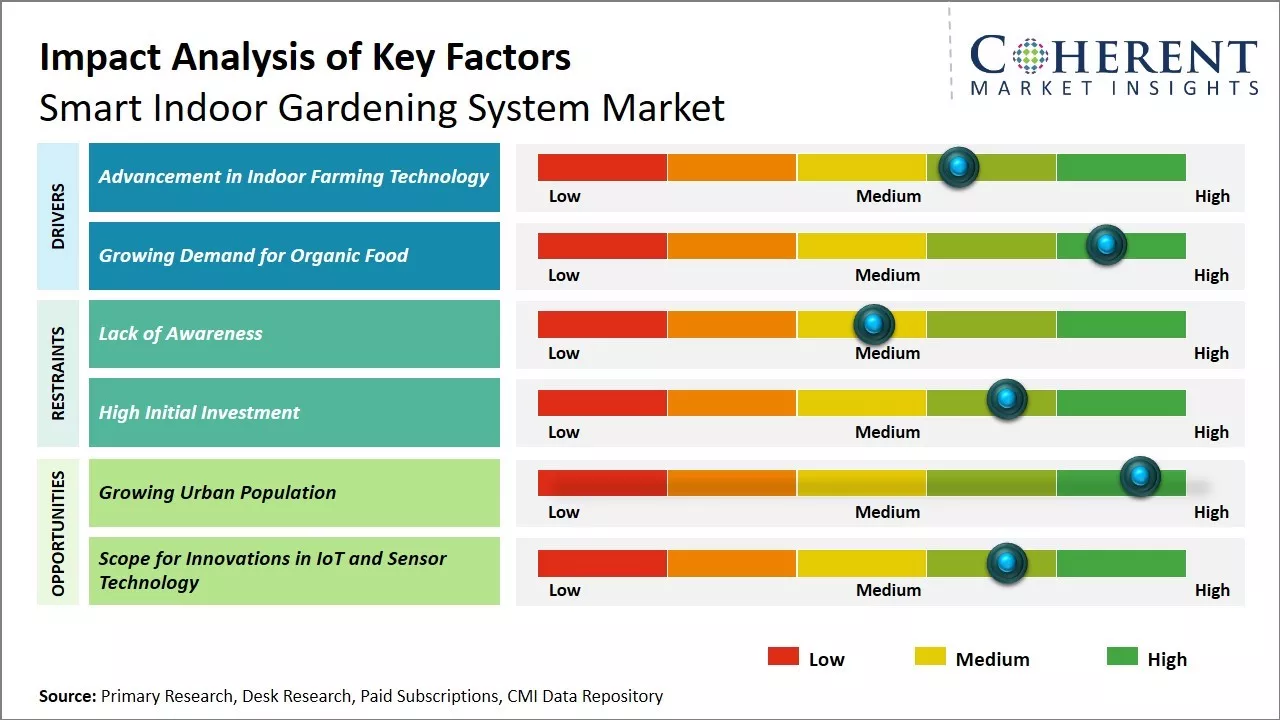
Discover market dynamics shaping the industry: Request sample copy
The indoor gardening system market is witnessing high growth owing to the increasing adoption of vertical and urban farming among consumers. Rising popularity of hydroponics and controlled environment agriculture have boosted the demand for smart indoor gardens as they allow year-round harvest of fruits and vegetables without dependency on weather conditions. Furthermore, innovations in internet of things (IoT), artificial intelligence, and digital technologies are enabling market players to develop advanced indoor gardening systems with smart features such as automated watering, nutrient delivery, and monitoring. Consumers prefer these smart systems for their ease of use and ability to grow herbs and leafy greens with minimum effort.
Advancement in Indoor Farming Technology
With the advancement of technology, indoor farming has become quite sophisticated. Smart indoor gardening systems have been developed which leverage various technologies, such as IoT, artificial intelligence, robotics, and sensor technology, to optimize the growing conditions for plants. These systems track various parameters like temperature, humidity, sunlight exposure, and automatically regulate them to offer the ideal environment for plant growth. Sensors monitor soil moisture levels, pH balance, and other factors. The system uses this data to determine precise watering and nutrient needs of individual plants.
Some systems come equipped with LED grow lights which can be automatically adjusted based on the light requirements of different plants. The lights are programmed to mimic the natural light cycle and provide the correct spectrum. AI and machine learning algorithms help analyze historical data on plant health and conditions. Over time, the system learns what changes optimize growth. It then applies this knowledge to continuously tweak environmental settings. Cameras and vision systems allow for round-the-clock monitoring of plants. Any issues like signs of disease or nutrient deficiency can be quickly identified. Robots are used for tasks like watering, feeding and transporting plants. This reduces labor needs. The data collected is stored on the cloud and can be accessed remotely. Growers can monitor plants and control the system using a smartphone app.
Such smart indoor gardening technologies offer a variety of benefits for urban farming. They allow for year-round harvests as environmental conditions can be precisely controlled. Vertical and stacked designs make optimal use of limited space in urban areas. No adverse weather impacts production. Using data analytics capabilities, higher yields can be achieved along with more consistency in crop quality. Automation minimizes labor costs and frees up time for farmers. For consumers, it ensures a stable local supply of fresh produce. Overall, advancements in indoor farming technology are fueling the adoption of smart indoor gardening systems. As urban populations increase, these solutions will become more popular for sustainable food production within cities.
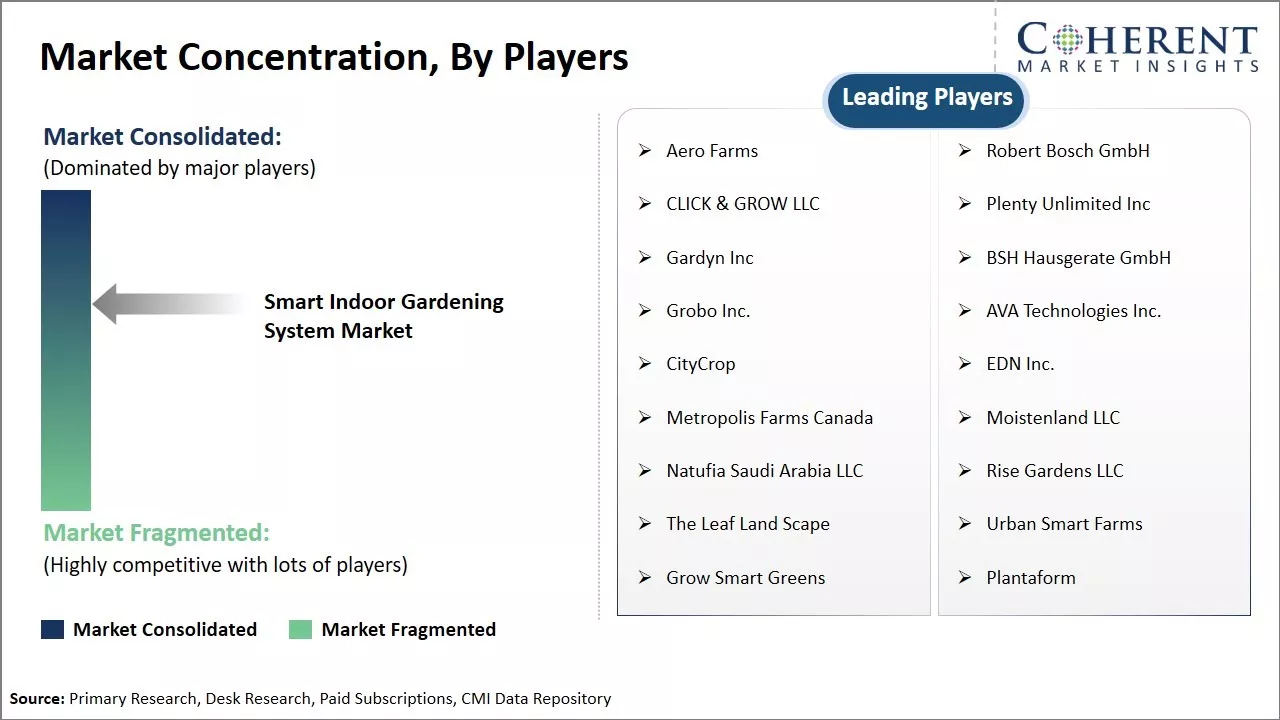
Get actionable strategies to beat competition: Request sample copy
Growing Demand for Organic FoodThe demand for organic and fresh produce has been steadily increasing over the past decade owing to rising health consciousness among consumers. People are increasingly preferring foods that are grown without the use of pesticides and chemical fertilizers. At the same time, traditional gardening requires large outdoor spaces which are not available to many urban dwelling consumers. This has driven the growth of indoor gardening systems that enable people to grow vegetables, herbs, and other plants inside their homes irrespective of the space availability.
Smart indoor gardening systems take indoor gardening to the next level by automating several processes through the use of advanced technologies like hydroponics and controlled environment agriculture. These systems come with features such as self-watering, automatic temperature, and humidity control, LED lighting optimized for plant growth, etc., allowing users to garden indoors with minimum effort. Such automated systems are well-suited for beginners and busy urban lifestyles as they eliminate many of the challenges associated with traditional gardening like the requirement of daily watering and monitoring of temperature and lighting conditions.
According to statistics from the Food and Agriculture Organization, the global sales of organic foods increased by 72% from 2014 to 2019 reaching USD 120 billion. The COVID-19 pandemic has further accelerated this demand as more people strived for healthy and nutritious home-cooked meals. The pandemic also highlighted the importance of food security and organic local production. With urban populations expected to rise, indoor gardening is poised to become an increasingly important way for urban dwellers to grow their own greens. Smart indoor gardening systems address many of the concerns of urban gardening like space, access to sunlight and garden maintenance, making them an ideal solution to the rising demand for organic produce. The market is expected to witness robust growth over the coming years as both the appetite for organic foods as well as indoor gardening increases globally.
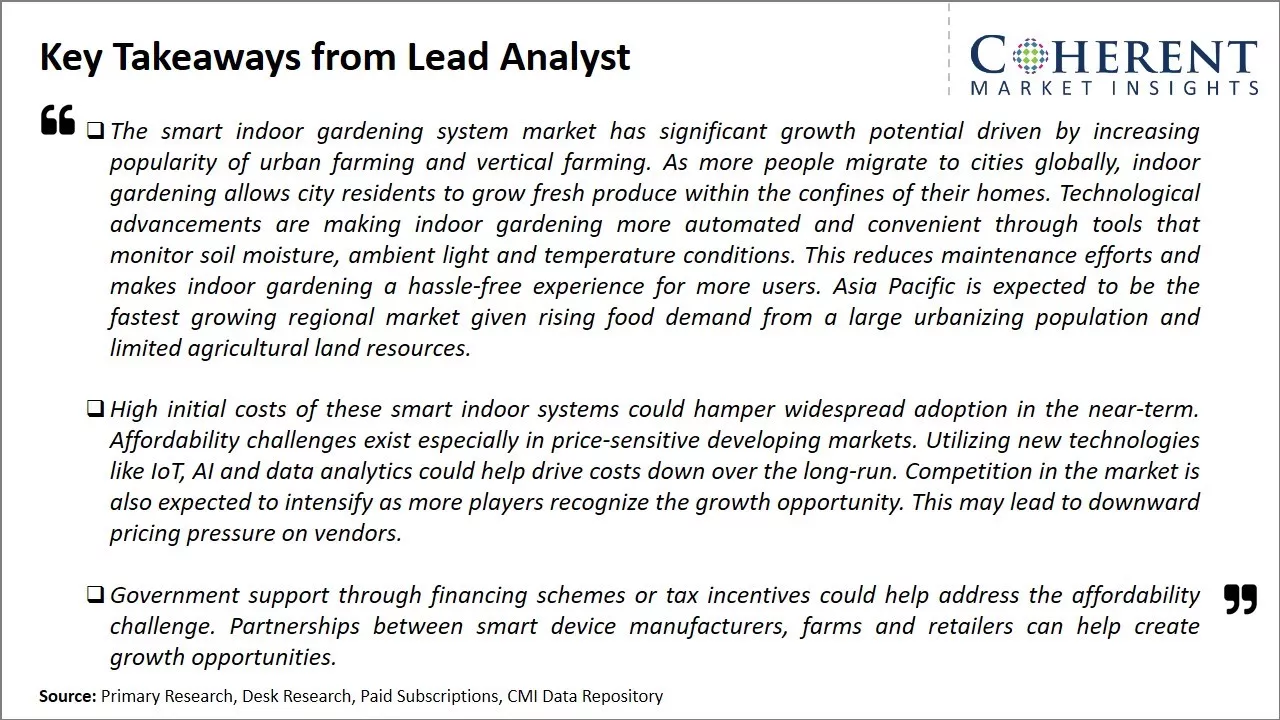
To learn more about this report, Request sample copy
Market Challenges: Lack of AwarenessThere are several challenges currently being faced by the smart indoor gardening system market. Due to the niche nature of these products, widespread customer awareness and adoption is still low. Additionally, the initial costs associated with these systems can be prohibitive for many customers. Maintaining consistent indoor growing conditions also presents a technical challenge, as environmental factors like temperature, humidity, light, and water must be carefully controlled. Customers may be hesitant regarding the ongoing costs for consumables like nutrients, seeds, and replacement parts over the lifetime of use.
Market Opportunities: Growing Urban Population
The rapid urbanization around the world presents a big opportunity for the smart indoor gardening system market. As more people migrate to cities for employment and other opportunities, urban populations are increasing dramatically. Smart indoor gardening systems that use technologies like hydroponics and controlled environmental systems help people in urban settings start their own mini-gardens without a yard or outdoor space. These systems use sophisticated sensors and automation to regulate factors like light, temperature, humidity, and nutrients. Lights and nutrients are precisely controlled with apps and AI to maximize plant growth and yield even in small indoor spaces. Companies are innovating new smart indoor garden formats like vertical gardens and countertop gardens that use minimal space.
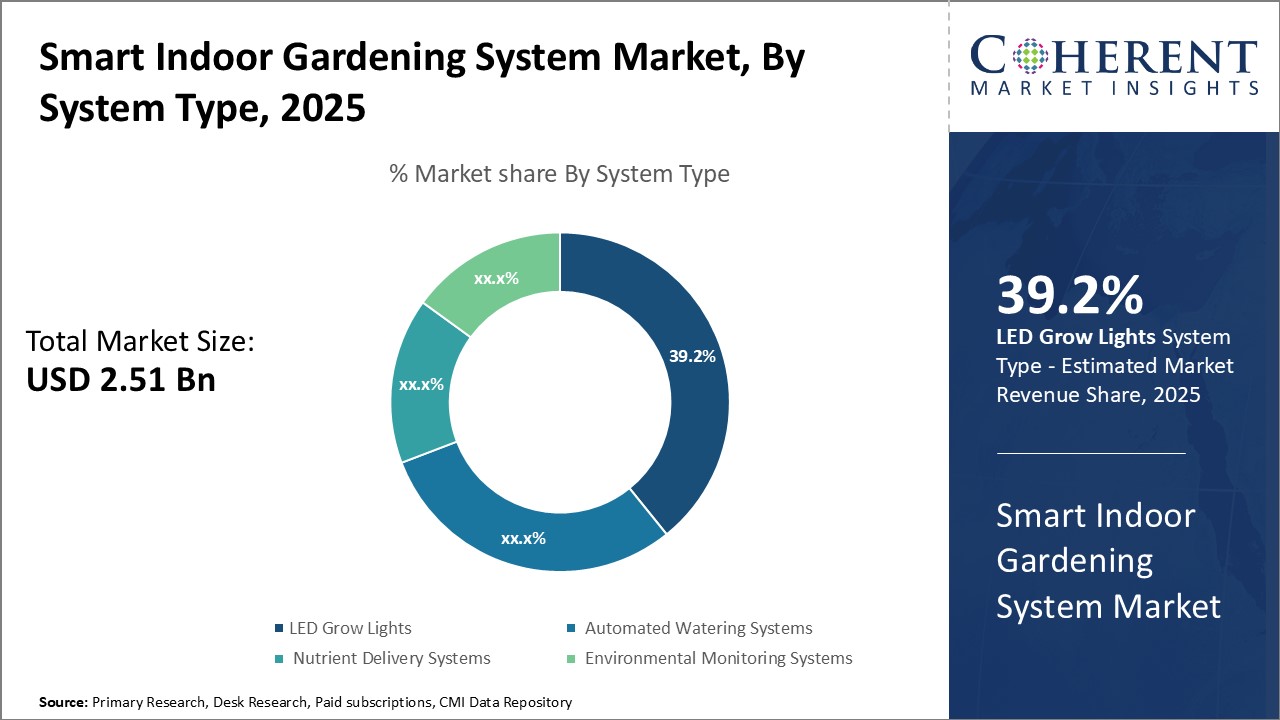
Discover high revenue pocket segments and roadmap to it: Request sample copy
Insights, by System Type: Factors Accelerating LED Grow Light AdoptionThe LED grow lights segment is estimated to contribute the highest share of 39.2% in 2025 in the market owing to several advantages over traditional lighting methods. LED lights allow for precise control over the light spectrum and intensity, which can be customized to meet the needs of different plant varieties and growth stages. This targeted lighting helps optimize photosynthesis and boosts crop yields. LEDs also emit very little heat, preventing damage or shocking of temperature-sensitive plants. Their long lifespan and low energy consumption compared to HIDs or CFLs contributes to significant cost savings over time. As sustainability becomes a greater priority, LED lights are emerging as an environment-friendly solution with a smaller carbon footprint. Moreover, advancements enable full-spectrum lighting from a single diode, streamlining indoor growing set-ups. The proliferation of hydroponics and attractiveness of urban farming are further propelling the adoption of efficient, customizable grow lights.
Insights, by Growing Type - Factors Driving the Popularity of Hydroponic Systems
In terms of growing type, the hydroponic segment is estimated to contribute the highest share of 41.7% in 2024 in the market owing to key advantages over traditional soil-based methods. Hydroponics allows for precise nutrient delivery and environmental control. Growers can regulate factors like pH, temperature, humidity, and nutrients to optimize plant growth. This consistency yields higher, more reliable crop outputs throughout the year regardless of outdoor conditions. Hydroponic systems also utilize less space with vertical or multilayer farming. The ability to grow in any climate-controlled location expands agricultural opportunities for urban areas. Sustainable recirculation of nutrient-rich water also conserves valuable resources. Increased accessibility of equipment and understanding of the techniques have made hydroponics an attractive option for both commercial operations and home growers.
For instance, Growgreen Limited, smart garden equipment manufacturer, offers a revolutionary indoor hydroponic system that grows plants up to 10 times faster than soil.
Insights, by Application - Adoption in Commercial Applications
The commercial segment is estimated to contribute the highest share of 58.3% in 2025 in the market driven by the important benefits for producers. Larger hydroponic, aeroponic, and aquaponic greenhouses enable commercial growers to achieve economies of scale. Precise environmental control allows year-round harvests and multiple crop rotation cycles annually. This high and consistent yield helps ensure return on investment. Controlled growing conditions also make it possible to produce specialized and high-value crops in any season. The ability to locate production closer to urban consumer bases helps reduce transportation costs and time to market for perishable goods. Indoor vertical farms capitalize on limited space in densely populated cities to sustain local food systems. Commercial operations help address global food security challenges through sustainable intensive cultivation methods.
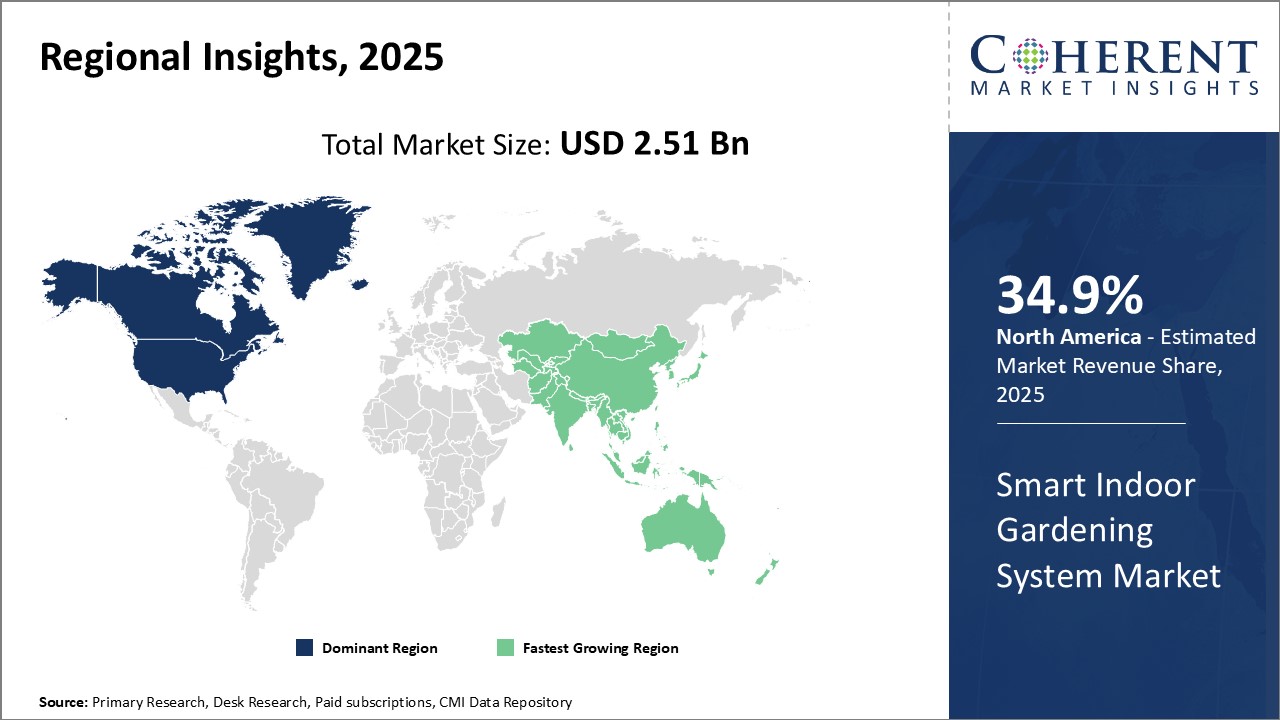
Need a Different Region or Segment? Customize now
North America has established itself as the dominant region in the global smart indoor gardening system market. The region is estimated to account for market share of 34.9% in 2025. Home to some of the largest indoor farming companies and agricultural technology startups, the U.S. accounts for over 40.5% of the total market share. Canadian households also exhibit high adoption rates for technologically-advanced indoor gardening solutions. The presence of industry giants like AeroGarden and Click & Grow has enabled wide product availability and strong brand awareness across the region.
Stringent food safety regulations and quality standards in the U.S. and Canada have further encouraged indoor farming practices. These countries are also global leaders in research and development related to controlled environment agriculture. Many local universities and agrotech firms are developing innovative vertical farming and hydroponics techniques. The North American market also benefits from robust infrastructure and logistics networks to support indoor agricultural operations at scale.
Among growing regions, Asia Pacific displays the most promising growth potential. Countries like China, Japan, and South Korea are increasingly embracing urban agriculture to meet the needs of dense urban populations and smaller living spaces. Growing health consciousness and changing consumer preferences for locally grown fresh produce are also driving adoption. While the market is currently fragmented with several small players, local governments are proactively supporting indoor farming startups through incentives and project funding.
Indoor gardening systems in Asia Pacific also enjoy competitive price points compared to other global markets. This is attributed to lower manufacturing costs and a thriving ecosystem of component suppliers. Countries like China have emerged as leading export hubs for indoor garden kits, hydroponic racks, and grow lights. With strong economic growth driving rising disposable incomes, Asia Pacific's smart indoor gardening system market is well positioned for continued expansion in the coming years.
Smart Indoor Gardening System Market Report Coverage
| Report Coverage | Details | ||
|---|---|---|---|
| Base Year: | 2024 | Market Size in 2025: | USD 2.51 Bn |
| Historical Data for: | 2020 To 2024 | Forecast Period: | 2025 To 2032 |
| Forecast Period 2025 to 2032 CAGR: | 6.4% | 2032 Value Projection: | USD 3.88 Bn |
| Geographies covered: |
|
||
| Segments covered: |
|
||
| Companies covered: |
Aero Farms, Robert Bosch GmbH, CLICK & GROW LLC, Plenty Unlimited Inc, Gardyn Inc, BSH Hausgerate GmbH, Grobo Inc., AVA Technologies Inc., CityCrop, EDN Inc., Metropolis Farms Canada, Moistenland LLC, Natufia Saudi Arabia LLC, Rise Gardens LLC, The Leaf Land Scape, Urban Smart Farms, Grow Smart Greens, and Plantaform |
||
| Growth Drivers: |
|
||
| Restraints & Challenges: |
|
||
Uncover macros and micros vetted on 75+ parameters: Get instant access to report
Share
Share
About Author
Monica Shevgan has 9+ years of experience in market research and business consulting driving client-centric product delivery of the Information and Communication Technology (ICT) team, enhancing client experiences, and shaping business strategy for optimal outcomes. Passionate about client success.
Missing comfort of reading report in your local language? Find your preferred language :
Transform your Strategy with Exclusive Trending Reports :
Frequently Asked Questions
Joining thousands of companies around the world committed to making the Excellent Business Solutions.
View All Our Clients
US Reciprocal Tax Impact Analysis On Smart Indoor Gardening System Market
Stay updated on tariff changes with expert insights and timely information